Self Watering Plant Pots
Are Self Watering Planters Worth It
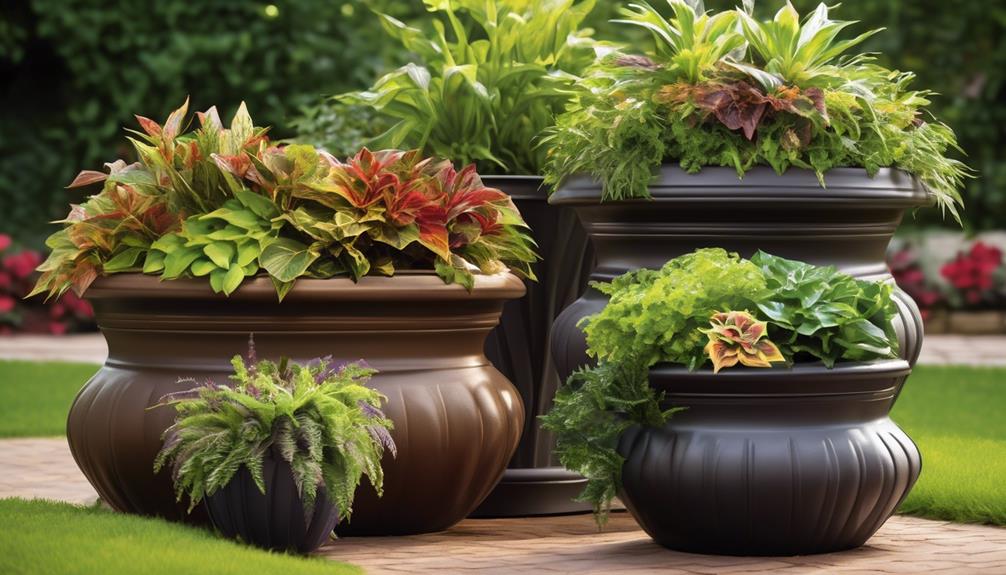
You’ve been thinking about ways to simplify plant care, haven’t you? Maybe the idea of self-watering planters has sparked your interest. The crucial point, however, is whether they really deliver on their promises, right?
Well, let's just say there's a lot to unpack when it comes to the pros and cons of these nifty gardening gadgets. But before we jump into any conclusions, it might be worth taking a closer look at what self-watering planters have to offer.
Key Takeaways
- Self-watering planters improve water efficiency and reduce maintenance requirements.
- They provide precise watering for optimal growth and offer convenience and cost savings for users.
- Self-watering planters have a positive environmental impact by reducing runoff and nutrient leaching.
- They promote consistent moisture levels for healthy plant growth and have robust root systems for nutrient uptake.
Advantages of Self Watering Planters
Self watering planters offer numerous benefits, including improved water efficiency and reduced maintenance requirements. These planters utilize a reservoir system to provide water to the plants as needed, leading to significant water savings and cost efficiency. The self-watering mechanism ensures that plants receive the precise amount of water required for optimal growth, preventing water wastage and evaporation. This efficient watering system not only conserves water but also reduces the frequency of manual watering, resulting in substantial cost savings and convenience for the users.
Furthermore, the consistent moisture levels maintained by self watering planters promote healthy plant growth. The controlled watering system prevents under or overwatering, which can be detrimental to plant health. By ensuring that plants receive the right amount of water at all times, these planters contribute to improved plant vitality and vitality.
Additionally, the reduced maintenance requirements associated with self watering planters make them an ideal choice for individuals seeking low-maintenance gardening solutions.
How Self Watering Planters Work
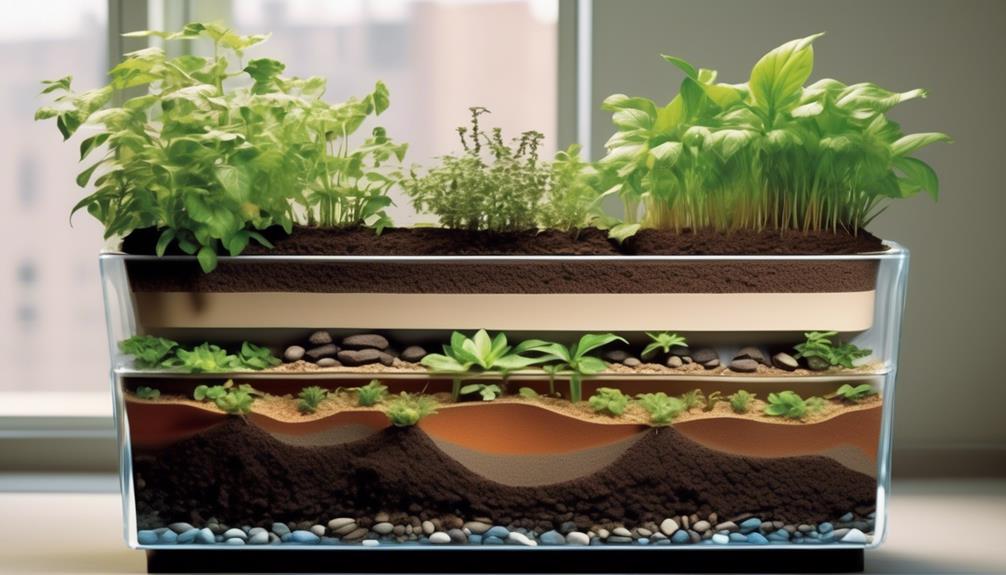
Self-watering planters operate on a simple and efficient mechanism that ensures plants receive the right amount of moisture at all times. These planters offer numerous benefits, including reduced water usage, minimized risk of overwatering or underwatering, and improved plant health.
Watering Mechanism Explanation
The irrigation system in self watering planters efficiently delivers water to the plant roots, maintaining optimal moisture levels for healthy growth. This system typically consists of a water reservoir at the bottom of the planter, connected to the soil through a wicking mechanism or capillary action. As the soil dries out, it draws up water from the reservoir, ensuring consistent moisture for the plants. This mechanism enhances watering efficiency by reducing water waste through evaporation or runoff.
It also provides a buffer against under or overwatering, as the plants can draw water as needed. Additionally, the self watering mechanism prevents waterlogging by allowing excess water to drain away from the root zone. This innovative approach to maintaining soil moisture contributes to the overall health and vitality of the plants.
Benefits of Self-Watering
Using a capillary action mechanism, the self watering planters maintain consistent moisture levels in the soil, promoting healthy plant growth and reducing water waste.
The benefits of self-watering systems include:
- Watering Efficiency:
- Self-watering planters reduce water wastage by providing just the right amount of water to the plants, avoiding overwatering or underwatering.
- The capillary action ensures that the soil retains optimal moisture, improving watering efficiency and conserving water resources.
- Environmental Impact:
- By reducing water consumption, self-watering planters contribute to environmental sustainability, making them an eco-friendly choice for gardening enthusiasts.
- The controlled watering mechanism minimizes runoff and nutrient leaching, thereby reducing the impact on the surrounding ecosystem.
- Convenience and Plant Growth:
- Self-watering planters offer convenience by reducing the frequency of watering, making them ideal for busy individuals.
- Consistent moisture levels support healthy plant growth, leading to lush and vibrant foliage.
Plant Health Improvement
Through the utilization of capillary action, self-watering planters function by consistently supplying moisture to the soil, thereby enhancing the overall health and well-being of the plants. The continuous availability of water ensures that plants receive the optimal amount of hydration, leading to improved growth and development. This method also reduces the likelihood of overwatering or underwatering, common issues associated with traditional plant care. As a result, the plants experience reduced stress and are better equipped to resist diseases and pests. Moreover, the consistent moisture levels promote robust root systems, which are essential for nutrient uptake and overall plant health. The improved plant health not only enhances the aesthetic appeal of the green space but also reduces maintenance efforts, allowing for a more sustainable and enjoyable gardening experience.
| Improved Growth | Reduced Maintenance | Enhanced Plant Health |
|---|---|---|
| Stronger, healthier plants | Less frequent watering | Reduced risk of diseases |
Types of Self Watering Planters
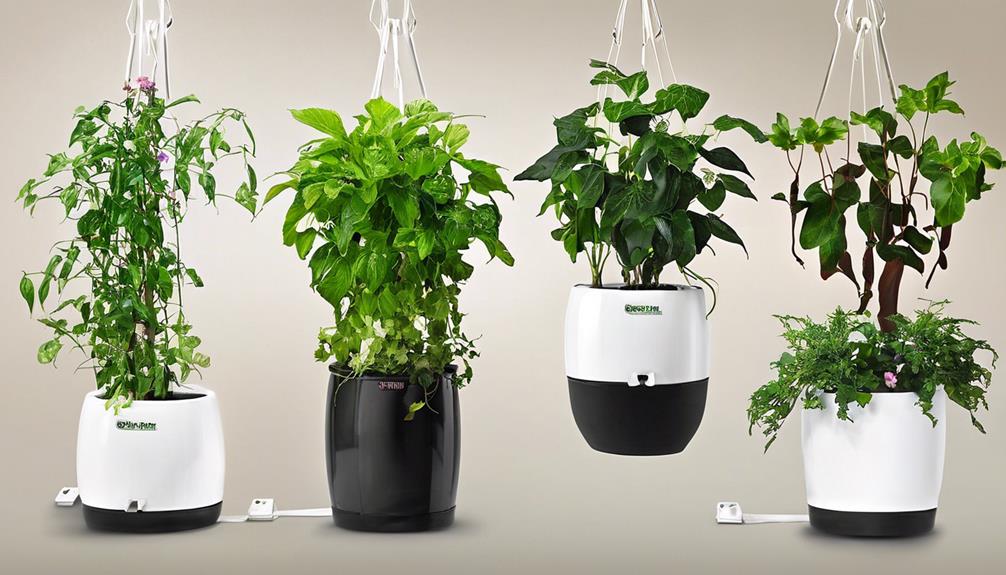
When it comes to self-watering planters, we'll be discussing the benefits of this system and the different reservoir options available.
Understanding the various types of self-watering planters can help us make informed decisions about which options are best suited for different plants and environments.
Benefits of Self-Watering
Self-watering planters, also known as self-irrigating or sub-irrigation planters, offer a convenient and efficient way to maintain optimal moisture levels for various types of plants.
The benefits of self-watering systems are numerous, including:
- Watering efficiency: Self-watering planters ensure that plants receive the right amount of water, reducing the risk of overwatering or underwatering. This promotes healthier root development and overall plant growth.
- Soil moisture: These planters help to maintain consistent soil moisture, preventing water stress and minimizing the need for frequent watering.
- Indoor, outdoor suitability: Self-watering systems are suitable for both indoor and outdoor use, allowing for flexibility in plant placement and making them ideal for various environments.
Self-watering planters are a practical solution for maintaining plant health while minimizing the effort and time required for watering maintenance.
Different Reservoir Options
We can classify self-watering planters based on their different reservoir options, which play a crucial role in maintaining optimal moisture levels for plants.
The efficiency of a self-watering planter largely depends on the material used for the reservoir. Materials like plastic, ceramic, and metal offer varying levels of water retention and durability.
Additionally, the size and placement of the reservoir within the planter are vital factors. A larger reservoir allows for less frequent refilling and provides a more stable moisture environment for the plant. Proper placement of the reservoir ensures an even distribution of water to the plant's roots.
Considering these aspects when choosing a self-watering planter can significantly impact its effectiveness in sustaining plant health. Therefore, understanding the reservoir options available is essential for making an informed decision when selecting self-watering planters.
Maintenance and Care Tips

To ensure optimal functioning and longevity of self-watering planters, regular cleaning and inspection of the watering system is essential. This helps to prevent clogging and ensures that the self-watering mechanism works effectively.
Here are some maintenance and care tips to consider:
- Cleaning: Regularly clean the watering system to remove any mineral deposits, algae, or mold that may affect its functionality. Use a mixture of water and mild soap to clean the reservoir and tubing, and rinse thoroughly before refilling.
- Inspection: Check the watering system for any signs of damage or wear, such as cracked tubing or malfunctioning float valves. Replace any worn or damaged parts to maintain the proper functioning of the self-watering planter.
- Soil Moisture Monitoring: Regularly monitor the soil moisture levels in the planter to ensure that the watering frequency is appropriate for the specific plant species. Adjust the watering frequency as needed to prevent overwatering or underwatering, which can adversely affect plant health.
Considerations Before Buying
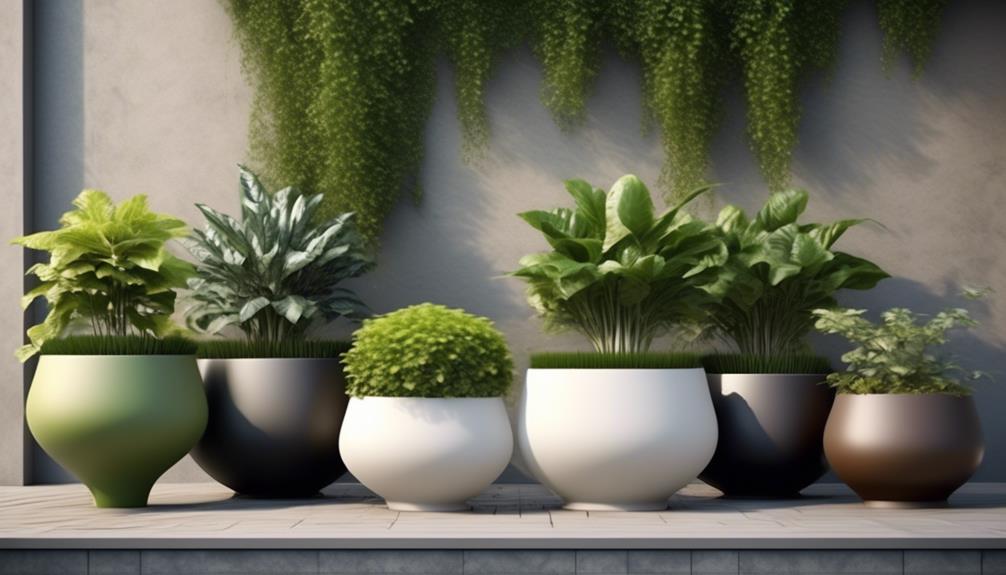
Regularly checking the maintenance needs of self-watering planters can inform the considerations before purchasing a new one. When considering buying a self-watering planter, material considerations play a significant role.
Planters made from high-quality, UV-stabilized plastic are durable and lightweight, making them suitable for both indoor and outdoor use. Additionally, materials such as terracotta or ceramic can provide a more aesthetic appeal but may require more maintenance to prevent cracking or breakage.
Size options are also crucial to consider. Larger planters offer more space for root growth and water reservoirs, reducing the frequency of refills and providing more stability for larger plants. However, smaller planters may be more suitable for limited spaces or smaller plants.
Furthermore, it's essential to consider the self-watering mechanism. Some planters have a wicking system that draws water from the reservoir into the soil, while others rely on a water level indicator to signal when it's time for a refill. Understanding these mechanisms can help determine which planter best fits the specific needs of the plants and the environment.
Lastly, considering the overall design and aesthetics in relation to the intended space is important to ensure the self-watering planter complements its surroundings.
Real Cost and Long-Term Benefits

Considering the real cost and long-term benefits of self-watering planters is essential for making an informed decision about their suitability for specific planting needs. When weighing the cost comparison between traditional planters and self-watering ones, it's important to note that self-watering planters generally have a higher upfront cost. However, the long-term benefits can offset this initial investment.
Here are some key points to consider:
- Cost Comparison
- Initial Investment: Self-watering planters are more expensive upfront due to their built-in watering systems and higher quality materials.
- Long-Term Savings: Over time, self-watering planters can save money on water bills and plant replacements due to their efficient water usage and reduced risk of plant stress.
- Environmental Impact
- Water Conservation: Self-watering planters typically use water more efficiently, reducing overall water consumption and promoting environmental sustainability.
- Reduced Waste: The longevity of plants in self-watering planters can lead to less plant waste, contributing to a more sustainable gardening practice.
Carefully evaluating the cost comparison and environmental impact of self-watering planters can help determine their overall value and feasibility for long-term planting needs.
Frequently Asked Questions
Can Self Watering Planters Be Used for All Types of Plants, Including Herbs and Vegetables?
Yes, self-watering planters can be used for all types of plants, including herbs and vegetables. They offer benefits such as efficient water conservation and improved plant health.
However, drawbacks may include the initial cost and potential for overwatering.
When implementing container gardening, self-watering planters can be a valuable tool for maintaining optimal moisture levels, which is crucial for the success of various plants in a home garden setting.
Are There Any Potential Drawbacks to Using Self Watering Planters, Such as Overwatering or Root Rot?
Potential drawbacks of self watering planters include the risk of overwatering and root rot. To mitigate these issues, regular maintenance and soil recommendations are crucial.
Indoor use may require different considerations than outdoor use. Replacement of components may be necessary over time.
Understanding these factors can help in making an informed decision about the benefits and potential drawbacks of using self watering planters for various types of plants.
How Long Do the Self Watering Mechanisms Typically Last Before Needing to Be Replaced or Repaired?
The longevity of self-watering mechanisms varies depending on the quality of the planter and its components. Regular maintenance can enhance their durability. Typically, these mechanisms can last several years before needing repair or replacement.
Maintenance requirements involve periodic checks for clogs, ensuring proper water distribution, and occasional component replacement. High-quality self-watering planters may have longer-lasting mechanisms, making them a worthwhile investment for those seeking convenience and efficient plant care.
Are There Any Specific Soil or Fertilizer Recommendations for Use With Self Watering Planters?
We've conducted extensive research on watering frequency and plant growth, as well as soil moisture and nutrient uptake.
When using self-watering planters, it's essential to select a well-draining soil mix to maintain optimal moisture levels.
Additionally, incorporating a balanced fertilizer with essential nutrients, such as nitrogen, phosphorus, and potassium, can enhance plant growth.
These specific soil and fertilizer recommendations are crucial for maximizing the benefits of self-watering planters and promoting healthy plant development.
Can Self Watering Planters Be Used Indoors as Well as Outdoors?
Self watering planters offer benefits such as consistent moisture and reduced watering frequency. They're ideal for urban dwellers and those with busy schedules. Self watering planters can be used indoors. However, outdoor use may be limited by extreme weather conditions and the need for regular refilling due to higher evaporation rates. Understanding these limitations and benefits can help in making an informed decision about incorporating self watering planters into indoor and outdoor gardening practices.
Are Self Watering Planters Effective for Keeping Plants Healthy?
Yes, the benefits of self watering planters are undeniable. These planters provide a consistent supply of water, ensuring that plants receive the right amount of moisture at all times. This helps to keep plants healthy and thriving, making self watering planters an effective option for plant care.
Conclusion
In conclusion, self watering planters are definitely worth the investment for their convenience, efficiency, and long-term benefits.
The visual imagery of a self watering planter effortlessly nourishing and sustaining a healthy plant represents the practicality and ease of using this innovative gardening solution.
When considering the real cost and long-term benefits, self watering planters prove to be a valuable addition to any home or garden.
With a green thumb and a keen eye for detail, Kayla leads our content with expertise and enthusiasm. Her dedication to spreading the joy of home gardening is reflected in every piece of advice and tip shared. She ensures that our community receives the most reliable and practical gardening insights.
Self Watering Plant Pots
What to Plant in Self Watering Pots
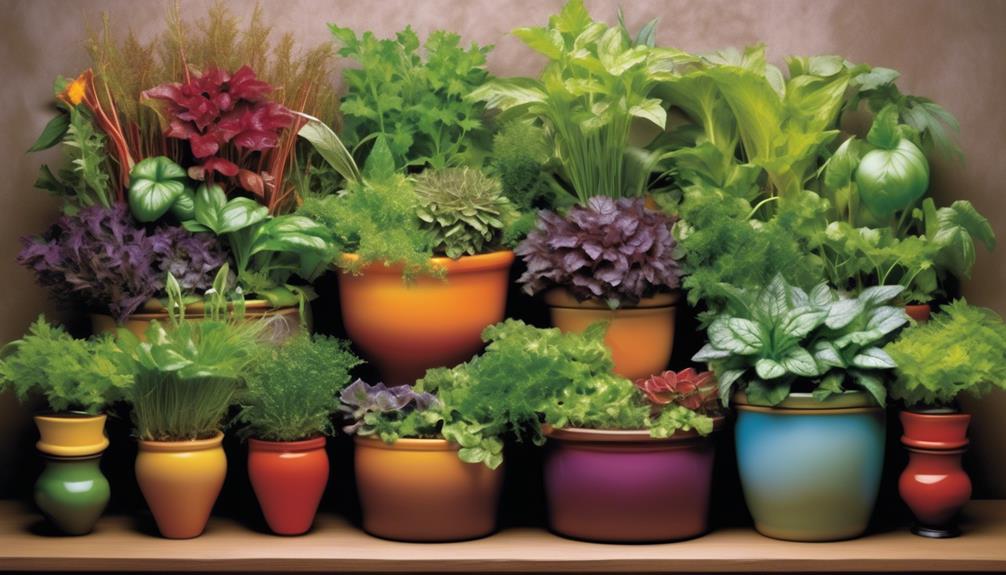
Utilizing self-watering containers is akin to employing a personal aide devoted to your plants’ well-being.
Picture this: a container that ensures your green companions receive just the right amount of hydration, without you having to constantly monitor and adjust their water intake.
But what types of plants thrive in these low-maintenance, yet efficient pots?
Well, we've got some insightful plant choices and expert tips to share.
So, let's explore the world of self-watering pots and discover the perfect match for your indoor or outdoor space.
Key Takeaways
- Self-watering pots provide consistent moisture to plants without frequent manual watering.
- Ideal plant choices for self-watering pots include herbs like basil and mint, flowering plants like African violets and peace lilies, snake plants, and pothos.
- Understanding the watering needs in self-watering pots involves considering the specific water requirements of each plant, environmental factors like temperature and humidity, pot size, monitoring root development, and regularly checking moisture levels in the potting mix.
- Plant-specific needs in self-watering pots include grouping plants with similar water needs together, adjusting watering frequency based on plant type, regularly monitoring soil moisture levels, and using appropriate watering techniques for different plant varieties.
Benefits of Self-Watering Pots
One significant benefit of self-watering pots is their ability to provide consistent moisture to plants without the need for frequent manual watering. This watering efficiency is achieved through a reservoir system that allows plants to draw up water as needed, ensuring that the soil moisture remains at an optimal level. This consistent moisture supply is crucial for plant health, as it prevents both under and over-watering, which can lead to root rot, wilting, or stunted growth. By maintaining a steady moisture level, self-watering pots create an ideal environment for plants to thrive.
Furthermore, the consistent moisture supply in self-watering pots promotes strong and healthy root development. With a consistent water supply, plants are encouraged to develop deeper and stronger root systems as they search for water, ultimately making them more resilient and better equipped to withstand periods of drought. This enhanced root development also leads to overall healthier and more vigorous plants, with increased resistance to diseases and pests.
Ideal Plant Choices
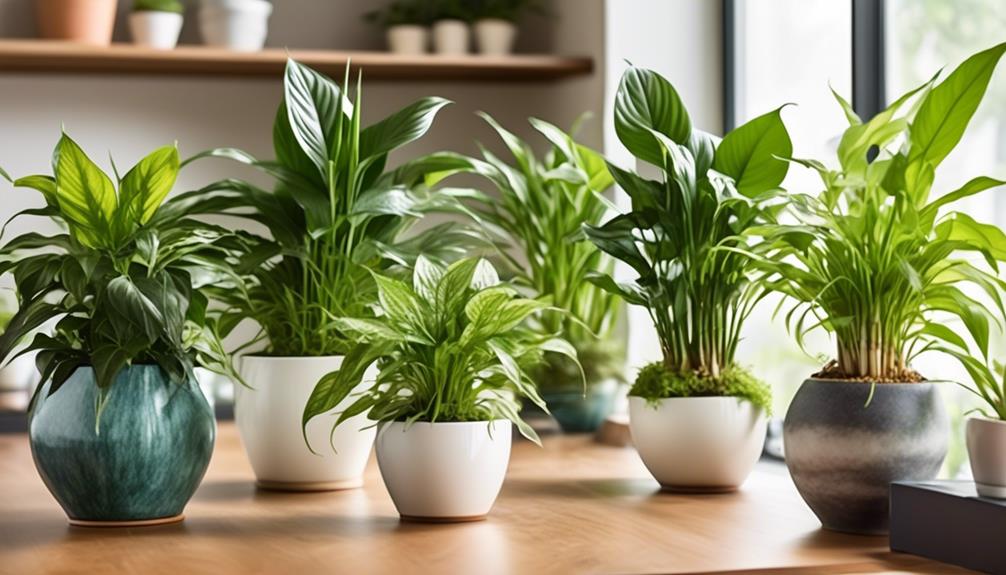
When selecting plants for self-watering pots, it's crucial to consider the specific needs of each variety. Certain plants, such as herbs like basil and mint, thrive in these pots due to their moderate water requirements.
Additionally, flowering plants like African violets and peace lilies are excellent choices for self-watering pots, as they benefit from consistent moisture levels.
Best Plant Options
When considering the best plant options for self-watering pots, it is essential to choose species with moderate water requirements and adaptability to container gardening. Some ideal plant choices for self-watering pots are those that thrive in well-draining soil and can withstand periods of dryness in between watering. Here are some top plant options for self-watering pots:
| Plant Name | Water Requirements |
|---|---|
| Snake Plant | Low |
| Peace Lily | Moderate |
| Spider Plant | Low |
| Pothos | Low |
| ZZ Plant | Low |
These plants are not only low maintenance but also have the ability to thrive in the controlled environment of self-watering pots, making them perfect choices for those looking to add greenery to their indoor spaces without the hassle of frequent watering.
Suitable Plant Varieties
Suitable plant varieties for self-watering pots should exhibit characteristics such as moderate water requirements and adaptability to container gardening, ensuring their ability to thrive in this specific growing environment. When selecting suitable plant varieties for self-watering pots, consider the following factors:
- Dwarf Citrus Trees: Compact and well-suited to container gardening.
- Herbs: Culinary herbs like basil, thyme, and oregano are excellent choices for self-watering pots.
- Succulents and Cacti: These plants have low water requirements and are well-adapted to dry conditions.
- Ferns: Certain fern varieties, such as maidenhair ferns, thrive in self-watering pots due to their moderate water needs.
- Peppers: Many pepper varieties are well-suited to container gardening and can thrive in self-watering pots with proper care.
Understanding Watering Needs
We need to pay close attention to the watering frequency, soil moisture levels, and plant-specific needs when utilizing self-watering pots. Understanding the specific requirements of each plant in terms of water is crucial for their overall health and growth.
Watering Frequency
Understanding the watering needs of plants in self-watering pots is essential for maintaining their health and ensuring optimal growth. When it comes to watering frequency, the built-in watering technology and moisture control features of self-watering pots play a crucial role. Here are some key points to consider:
- Plant Type: Different plants have varying water needs, so it's important to consider the specific requirements of the plant species being grown.
- Climate: Environmental factors such as temperature and humidity can affect the rate at which plants absorb water.
- Pot Size: The size of the self-watering pot can influence the frequency of watering required.
- Root Development: Monitoring the growth and development of the plant's roots can provide insight into its water uptake.
- Moisture Monitoring: Regularly checking the moisture levels in the potting mix helps in determining the appropriate watering frequency.
Soil Moisture Levels
Monitoring soil moisture levels in self-watering pots is crucial for understanding the watering needs of plants, as it directly impacts their health and growth. Testing soil moisture can be done using various methods such as a moisture meter, finger test, or observing the color and weight of the soil. Monitoring moisture levels is essential to prevent overwatering or underwatering, both of which can harm plant health. The following table illustrates the ideal moisture levels for common plants in self-watering pots.
| Plant Type | Soil Moisture Level |
|---|---|
| Succulents | Low |
| Herbs | Medium |
| Leafy Greens | High |
Understanding and maintaining the appropriate soil moisture levels for different plant types is vital for successful growth and development.
Plant-Specific Needs
To ensure the proper watering of plants in self-watering pots, it's essential to consider the specific water needs of each plant type. When it comes to plant placement, it's crucial to group plants with similar watering needs together to ensure proper hydration. Additionally, understanding the watering techniques for each plant is essential for maintaining their health.
Here are some specific considerations for plant-specific watering needs:
- Group plants with similar water needs together
- Consider the water requirements of each plant species
- Adjust watering frequency based on plant type
- Monitor soil moisture levels regularly
- Use appropriate watering techniques for different plant varieties
Indoor Plant Recommendations

When selecting indoor plants for self-watering pots, it's crucial to consider their specific light and moisture requirements to ensure successful growth and maintenance.
For indoor gardening in self-watering pots, we recommend low-maintenance plants such as snake plants (Sansevieria) and pothos (Epipremnum aureum). These plants thrive in low to moderate light and can tolerate occasional missed waterings, making them ideal for self-watering pots.
For those seeking a flowering option, peace lilies (Spathiphyllum) and African violets (Saintpaulia) are excellent choices. Peace lilies prefer moderate indirect light and consistently moist soil, while African violets require bright, indirect light and consistently moist but not waterlogged soil.
When it comes to plant care, it's important to note that self-watering pots can lead to overwatering if not monitored carefully. Therefore, it's essential to select plants that prefer slightly drier conditions to prevent root rot and other moisture-related issues.
Outdoor Plant Recommendations
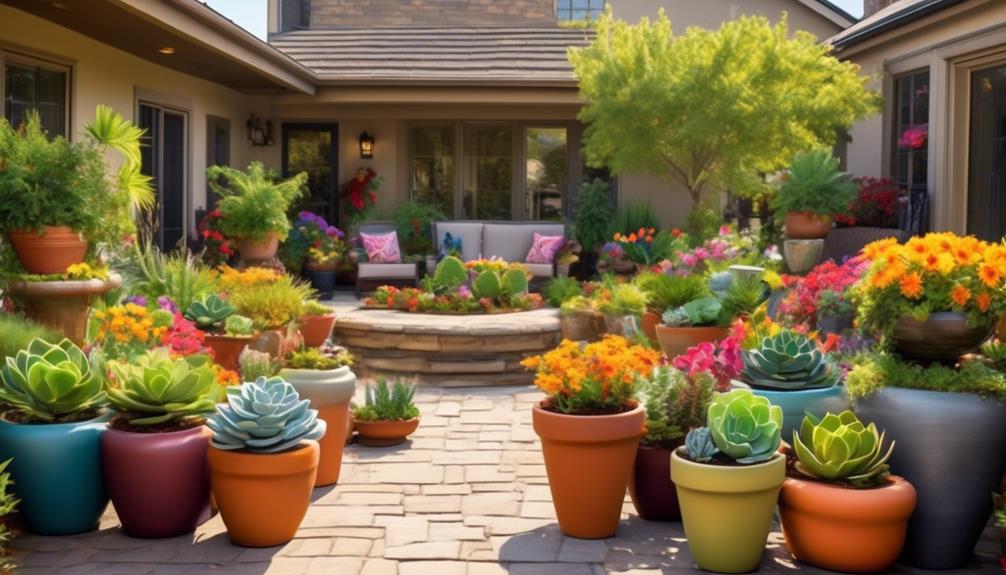
When it comes to outdoor plant recommendations for self-watering pots, we've found that sun-loving flowers such as petunias and marigolds thrive in these containers.
Drought-resistant herbs like lavender and rosemary are also excellent choices for outdoor self-watering pots due to their low water requirements.
Additionally, compact vegetables like cherry tomatoes and peppers are well-suited for self-watering pots, making them ideal options for outdoor gardening in limited spaces.
Sun-Loving Flowers
How can we select sun-loving flowers that are suitable for outdoor planting in self-watering pots? When choosing sun-loving flowers for self-watering pots, it's crucial to consider their soil and maintenance needs. Here are some recommendations:
- Soil Preparation: Opt for well-draining soil mixes with added perlite or sand to enhance drainage and prevent waterlogging.
- Proper Drainage: Ensure the self-watering pots have adequate drainage holes to prevent water accumulation, which can lead to root rot.
- Pruning: Regularly prune sun-loving flowers to remove dead or decaying parts and encourage new growth.
- Deadheading: Deadhead spent blooms to promote continuous flowering and prevent the plant from wasting energy on seed production.
- Watering: Despite the self-watering feature, monitor soil moisture regularly to prevent overwatering, especially in hot weather.
Selecting sun-loving flowers and maintaining them properly will ensure vibrant blooms in your outdoor self-watering pots.
Drought-Resistant Herbs
Selecting drought-resistant herbs for outdoor planting in self-watering pots requires careful consideration of their water needs and adaptability to varying environmental conditions.
When engaging in container gardening, especially in small spaces, it's crucial to choose herbs that can thrive with minimal water.
Culinary herbs like rosemary, thyme, and oregano are excellent choices for outdoor self-watering pots due to their ability to withstand dry conditions.
These herbs are well-suited for small spaces and can be placed in outdoor kitchens or on a kitchen windowsill, providing easy access for culinary use.
Their adaptability to drought makes them ideal for self-watering pots, ensuring they receive the right amount of water without the risk of overwatering.
Compact Vegetables
Compact vegetables suitable for outdoor planting in self-watering pots require specific characteristics to thrive in limited space and maintain healthy growth. When considering container gardening for space-saving or urban farming on balconies, it's essential to select vegetables that are well-suited for compact environments.
Here are some recommended compact vegetables for outdoor planting in self-watering pots:
- Cherry Tomatoes
- Dwarf Carrots
- Baby Bell Peppers
- Miniature Cucumbers
- Bush Beans
These vegetables are ideal for small spaces, as they've been bred to flourish in confined areas. When grown in self-watering pots, they can thrive without the need for extensive root systems.
Herbs and Edibles for Pots
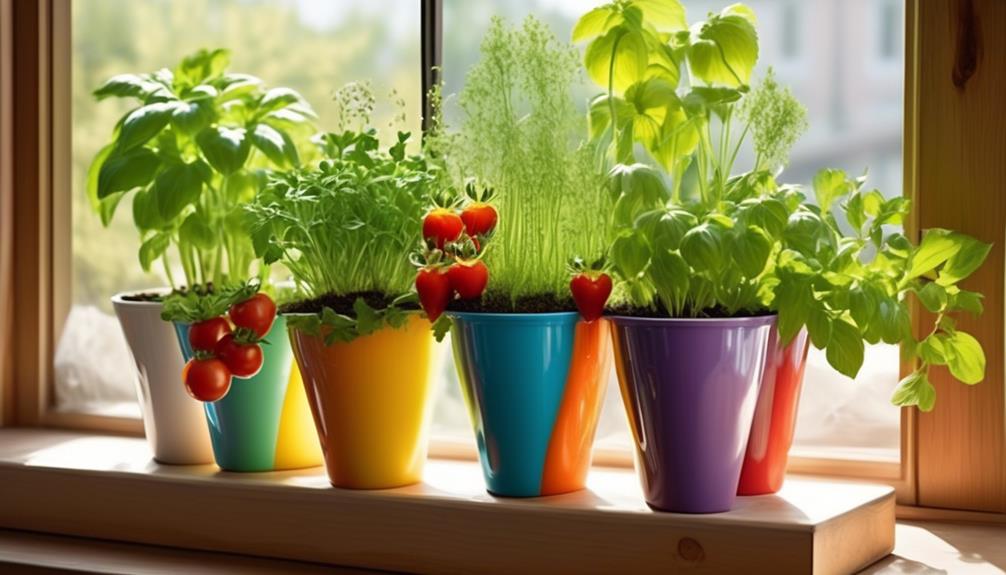
When choosing herbs and edibles for pots, it's important to consider the plant's size and growth habits to ensure they're suitable for the container environment. Container gardening and urban farming enthusiasts often seek to maximize space and productivity, making herbs and edibles an excellent choice for small-scale cultivation.
Herbs like basil, thyme, and rosemary are well-suited for pots due to their compact growth and low maintenance requirements. Additionally, they can thrive in a variety of light conditions, making them adaptable to urban settings with limited direct sunlight.
When it comes to edibles, compact varieties of vegetables such as cherry tomatoes, dwarf peppers, and mini cucumbers are ideal for pot cultivation. However, other edibles like lettuce, spinach, and kale can also thrive in pots, providing a fresh supply of leafy greens in limited spaces.
Careful consideration of the pot size, soil quality, and watering requirements is crucial for the successful growth of herbs and edibles in containers.
Flowering Plants for Color

Considering the space-saving nature of container gardening, it's essential to carefully choose flowering plants for pots that not only add color but also thrive in a confined environment. When selecting flowering plants for self-watering pots, it's important to opt for varieties that offer seasonal blooms and vibrant foliage, especially for balcony gardening.
Here are some top choices to consider:
- Begonias: These plants offer a profusion of colorful flowers and are well-suited for container gardening due to their compact size and tolerance for shade.
- Petunias: With their trumpet-shaped flowers in various hues, petunias are excellent choices for adding a pop of color to self-watering pots. They thrive in sunny locations and are known for their continuous blooming.
- Geraniums: Ideal for balcony gardening, geraniums produce clusters of blooms in an array of colors, making them a popular choice for adding visual interest to container gardens.
- Marigolds: These easy-to-grow flowers provide seasonal blooms in vibrant shades of yellow and orange, adding a cheerful touch to self-watering pots.
- Salvia: Known for its striking spikes of flowers, salvia offers a long-lasting display of color and is well-suited for container gardening due to its adaptability to different light conditions.
Low-Light Options

In low-light conditions, selecting flowering plants for self-watering pots requires careful consideration to ensure their adaptability and ability to thrive without ample sunlight.
For shade-tolerant options, consider the peace lily (Spathiphyllum), which features elegant white blooms and glossy green leaves. It thrives in low light and enjoys consistently moist soil, making it an ideal choice for self-watering pots.
Another great option is the snake plant (Sansevieria trifasciata), known for its striking upright leaves and tolerance for low-light environments. This plant is well-suited for self-watering pots due to its ability to withstand varying moisture levels.
For a pop of color, consider the African violet (Saintpaulia), which produces vibrant blooms and thrives in low light. It prefers consistently moist soil, making it a suitable candidate for self-watering pots.
When selecting moisture-loving plants for low-light conditions, it's important to ensure proper drainage to prevent waterlogging. With the right plant selection and attention to moisture levels, self-watering pots can support thriving, colorful displays even in low-light environments.
Succulents and Cacti
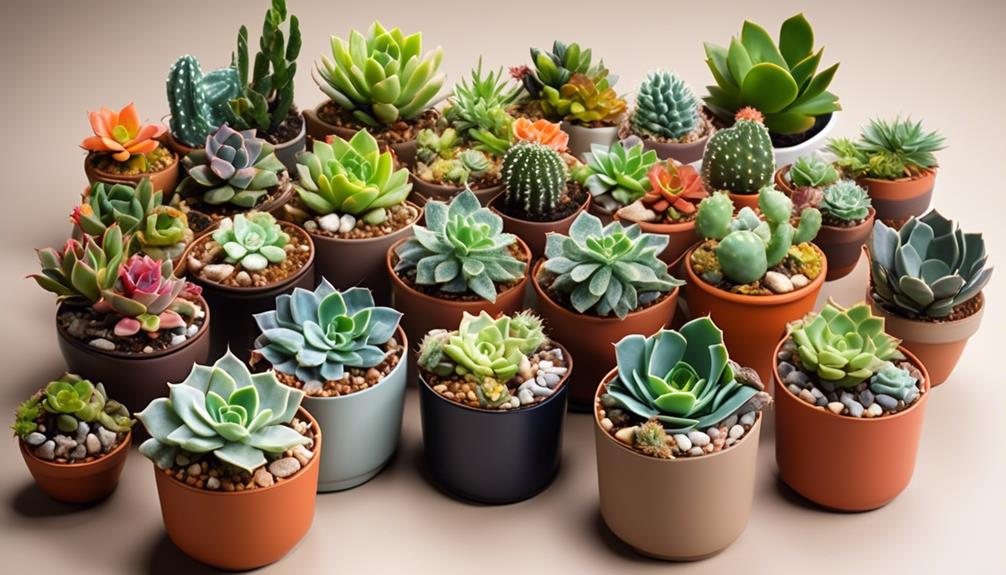
Succulents and cacti require well-draining soil and minimal watering, making them ideal choices for self-watering pots due to their ability to thrive in arid conditions. When selecting desert plant options for self-watering pots, it's crucial to consider their water-saving alternatives. Here are some key points to keep in mind:
- Soil Requirements: Utilize a well-draining soil mix specifically formulated for succulents and cacti. This type of soil allows excess water to drain away from the plant's roots, preventing waterlogged conditions.
- Watering Frequency: Succulents and cacti have low water requirements. With the self-watering feature of the pots, these plants only need occasional refills, ensuring that they receive the minimal water they need to thrive.
- Sunlight Exposure: Place the self-watering pots in areas with ample sunlight. Most succulents and cacti thrive in bright, direct sunlight, mimicking their natural desert habitat.
- Plant Selection: Choose succulent and cacti varieties that are well-suited for container growth. Opt for species that stay smaller and have shallow root systems.
- Temperature Considerations: Ensure that the self-watering pots are placed in environments with suitable temperatures for succulents and cacti. These plants prefer warm conditions and can tolerate high temperatures.
Maintenance Tips
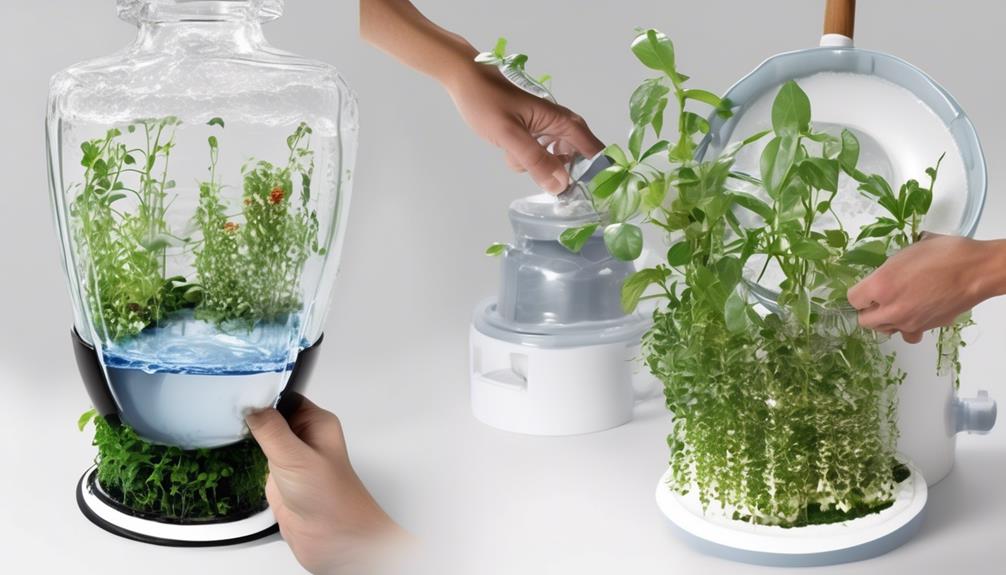
Given the unique watering requirements of succulents and cacti in self-watering pots, it is essential to understand the specific maintenance tips to ensure their continued health and growth. When it comes to container gardening, proper maintenance is crucial to the success of your plants. Here are some essential maintenance tips for your self-watering pots:
| Maintenance Tips | Description |
|---|---|
| Watering Techniques | Check the water reservoir regularly and refill it as needed. Water only when the soil is dry. |
| Soil Check | Inspect the soil for compactness and drainage. Replace the soil every 12-18 months if needed. |
| Pruning | Remove dead leaves, flowers, or stems to encourage healthy growth. |
| Cleaning | Clean the pot and reservoir periodically to prevent the buildup of algae or mineral deposits. |
| Fertilization | Use a diluted, balanced fertilizer during the growing season to support the plant's nutrition. |
These maintenance tips will aid in the proper care and growth of your succulents and cacti in self-watering pots. By following these guidelines, you can ensure that your plants thrive in their environment, contributing to the overall beauty of your space.
Best Practices for Success

To ensure optimal growth and health of succulents and cacti in self-watering pots, it's important to implement best practices for their care and maintenance. When engaging in container gardening with self-watering pots, the following best practices are essential for success:
- Choose the Right Soil Type: Select a well-draining soil mix specifically formulated for succulents and cacti. A mix that consists of coarse sand, perlite, and peat moss can provide the ideal growing medium.
- Monitor Watering Closely: Overwatering is a common issue that leads to root rot in succulents and cacti. Utilize the self-watering feature carefully and monitor the moisture levels in the soil to prevent waterlogged conditions.
- Provide Adequate Drainage: While self-watering pots can regulate moisture, it's crucial to ensure that excess water can still drain away. Check that the pot has sufficient drainage holes to prevent water from accumulating at the bottom.
- Control Sunlight Exposure: Place the self-watering pots in locations that offer the appropriate amount of sunlight for succulents and cacti. Typically, these plants thrive in bright, indirect light.
- Regular Maintenance: Inspect the plants regularly for any signs of overwatering, pests, or diseases. Prune as needed and repot when the plant outgrows its current container.
Frequently Asked Questions
Can Self-Watering Pots Be Used for Hydroponic Gardening?
Yes, self-watering pots can be used for hydroponic gardening. They offer benefits like water efficiency and reduced maintenance.
However, drawbacks include limited nutrient delivery and potential algae growth.
When compared to traditional gardening, hydroponic systems provide precise control over nutrient levels and faster growth rates.
Are There Any Specific Types of Soil or Growing Medium That Work Best in Self-Watering Pots?
When it comes to self-watering pots, the types of soil and growing medium options play a crucial role in the success of your plants. It's essential to consider factors like water retention, aeration, and nutrient availability.
Different plants may require specific soil types or growing mediums, so researching the needs of your specific plants is important. Options like peat-based mixes, coconut coir, or specialized potting soils can provide excellent results in self-watering pots.
How Do Self-Watering Pots Prevent Overwatering and Root Rot?
Preventing overwatering is crucial in self-watering pots. Proper drainage and water reservoirs help maintain the ideal moisture level, avoiding root rot.
The pots use a wicking system to provide water to the plants as needed, creating a self-regulating environment. This not only fosters healthy plant growth but also eliminates the risk of waterlogged soil.
The design ensures that excess water doesn't accumulate, effectively protecting the roots.
Can Self-Watering Pots Be Used for Larger Plants and Trees, or Are They Best Suited for Smaller Plants?
We've found that self-watering pots are suitable for large plants and trees, as they provide a consistent water supply to the roots.
When it comes to the best plants for self-watering pots, we've had success with a variety of options, including herbs, vegetables, and tropical plants.
The key is to select plants with moderate water needs and ensure the pot size accommodates the plant's root system.
Are There Any Specific Types of Fertilizer or Nutrients That Should Be Used With Self-Watering Pots?
When it comes to self-watering pots, selecting the right fertilizer and nutrients is critical. Different plants have varying nutrient requirements, so it's essential to choose a fertilizer that matches their needs.
Additionally, maintaining the appropriate watering schedule and moisture levels is crucial for optimal plant health in self-watering pots. We must be diligent in monitoring these aspects to ensure our plants receive the nutrients and water they need for thriving in self-watering pots.
Are Self Watering Pots Suitable for All Types of Plants?
Yes, self watering plant pots are suitable for a wide variety of plants. They work well for both indoor and outdoor plants, including herbs, flowers, and small fruits, by providing a consistent water supply. However, it’s still important to consider the specific watering needs of each individual plant before using a self watering pot.
Conclusion
In conclusion, self-watering pots offer a convenient and efficient way to care for plants. They require less frequent watering and reduce the risk of overwatering.
With the right plant choices and understanding of watering needs, these pots can thrive both indoors and outdoors.
Remember, 'a watched pot never boils,' so trust the self-watering system to do its job.
Enjoy the benefits of healthy, low-maintenance plants.
Self Watering Plant Pots
Large Self Watering Plant Pots
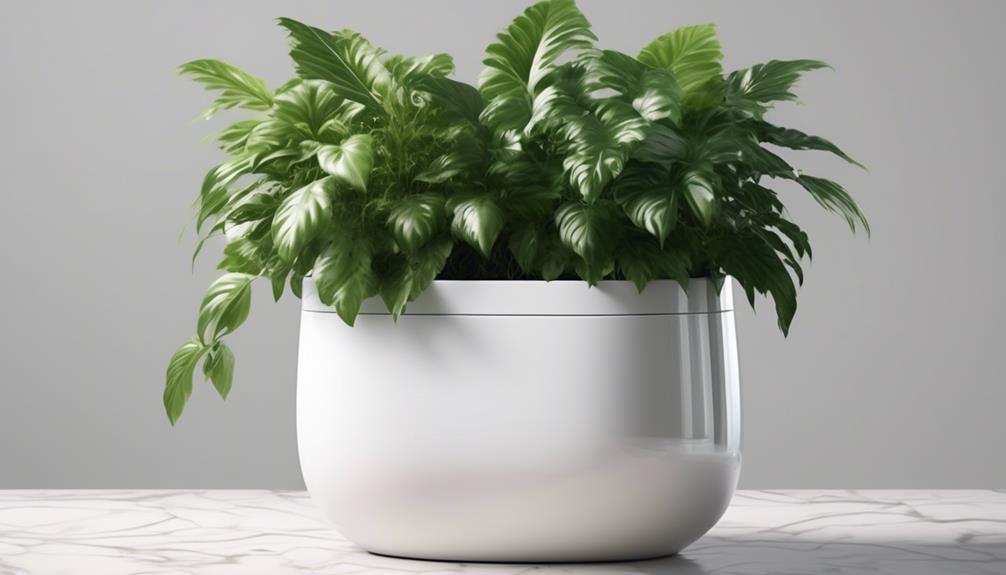
Regarding oversized self-watering planters, it can be confidently stated that plants seem healthier and more lively when grown in ours. These innovative pots are revolutionizing the experience for people who want to keep their plants flourishing with minimal effort.
But what sets these pots apart from traditional ones? And how exactly do they work? We'll explore the benefits, mechanics, and best practices for using large self-watering plant pots, so you can keep your greenery flourishing without all the fuss.
Key Takeaways
- Large self-watering pots efficiently maintain optimal moisture levels for plants.
- These pots reduce the need for frequent watering and minimize the risk of overwatering.
- They provide a consistent water supply to the roots, promoting healthy plant growth.
- The pots prevent soil from becoming waterlogged or drying out too quickly.
Advantages of Large Self-Watering Pots
Large self-watering pots provide an efficient and convenient method for maintaining optimal moisture levels for plants, reducing the need for frequent watering and minimizing the risk of overwatering. This is particularly advantageous for promoting healthy plant growth, as it ensures a consistent supply of water to the roots.
The key to this efficiency lies in the design of the pot, which incorporates a reservoir that holds excess water, allowing the plant to draw moisture as needed. This water retention capability is crucial, as it prevents the soil from becoming waterlogged while also preventing it from drying out too quickly. By maintaining the ideal moisture balance, large self-watering pots create an environment conducive to robust plant growth.
In serving the needs of others, it's important to consider the practical benefits of large self-watering pots. These pots not only save time and effort for caregivers and plant enthusiasts but also contribute to the overall health and vitality of the plants under their care. The ability to regulate water supply effectively is essential in providing optimum conditions for plant growth, and large self-watering pots excel in this aspect, making them a valuable tool for promoting plant well-being.
How Self-Watering Pots Work
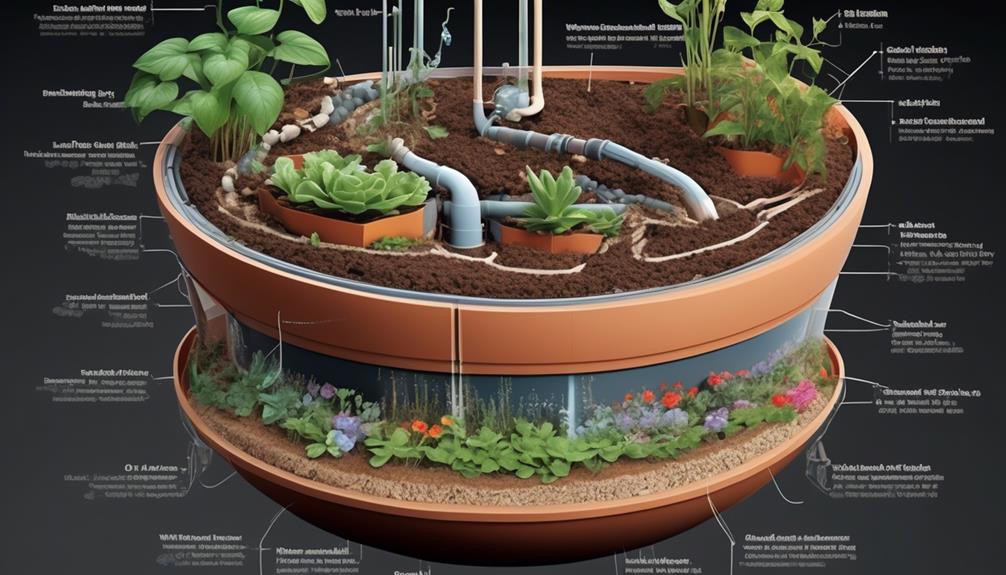
Understanding the mechanics of self-watering pots is crucial for grasping how these innovative containers efficiently deliver water to plant roots while preventing overwatering or rapid drying of the soil.
Self-watering pots work through a system that utilizes a reservoir at the bottom of the pot. This reservoir is filled with water, and the soil sits on top of a platform that allows the roots to access the water as needed.
A wicking mechanism, such as a wick or fabric, draws water from the reservoir up into the soil, ensuring consistent moisture for the plant.
The benefits of this system are multifaceted. It provides a constant source of water for plant hydration, promoting healthy growth and reducing the risk of under or overwatering.
Additionally, self-watering pots help to maintain an optimal level of soil moisture, preventing the soil from drying out too quickly.
This mechanism is particularly advantageous for individuals who may not have the time to water their plants regularly, making it an excellent option for those who desire serving others by providing a low-maintenance solution for plant care.
Choosing the Right Pot Size
When selecting a pot size for a self-watering plant system, it's essential to consider the specific needs of the plant species to ensure optimal growth and health. Selecting the appropriate size is crucial for the well-being of the plant.
The pot should provide enough space for the plant's roots to grow and expand, while also allowing for proper drainage. A pot that's too small can restrict root growth and lead to waterlogging, which may cause root rot and other health issues for the plant. On the other hand, a pot that's too large can hold excess water, leading to overwatering and potential root suffocation.
It's important to consider the mature size of the plant and choose a pot that will accommodate its growth over time. Additionally, proper drainage is essential to prevent water from pooling at the bottom of the pot, which can lead to root rot and other moisture-related problems.
Tips for Plant Care in Self-Watering Pots
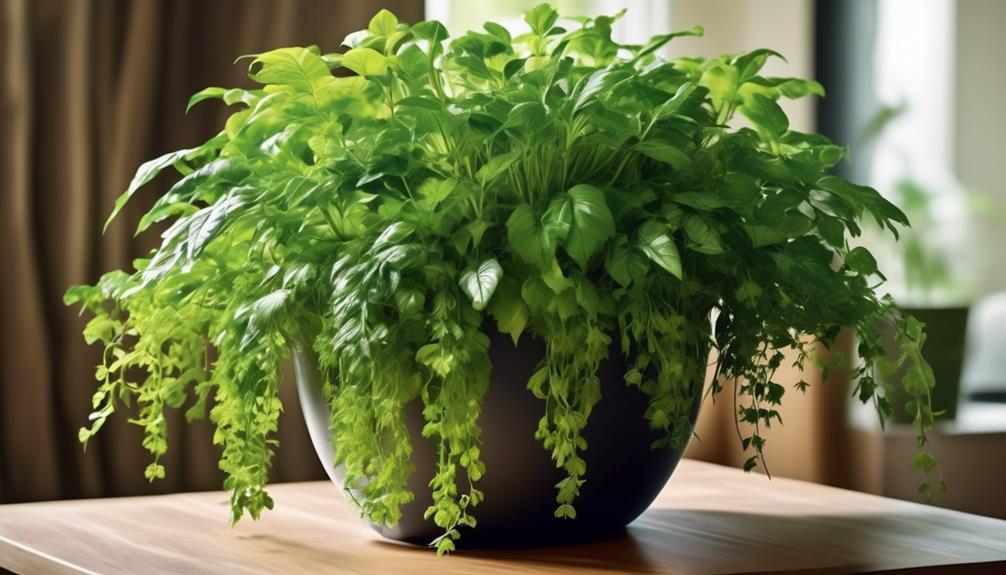
For optimal plant care in self-watering pots, it is essential to monitor the water level regularly and adjust as needed to maintain proper moisture levels. The frequency of watering in self-watering pots depends on various factors such as the plant type, pot size, and environmental conditions. To ensure the health of the plant, it's crucial to check the soil moisture and water level indicator of the pot regularly. Over-watering can lead to root rot and other issues, while under-watering can cause the plant to wilt and suffer. Maintaining the right balance is key to promoting healthy root growth and overall plant health.
| Watering Frequency | Soil Moisture | Root Health |
|---|---|---|
| Varied based on plant type, pot size, and environment | Monitor regularly using water level indicator | Crucial for promoting healthy root growth |
Additionally, the drainage system of self-watering pots plays a vital role in plant care. It helps prevent waterlogging, which can lead to root suffocation and diseases. It's important to ensure that the drainage system is functioning properly to maintain a healthy root environment. By paying attention to watering frequency, soil moisture, and the drainage system, one can ensure optimal care for plants in self-watering pots.
Best Plants for Self-Watering Pots
Choosing the right plants for self-watering pots is crucial for ensuring optimal growth and health. When considering plant selection for self-watering pots, it's important to choose species that thrive in consistently moist soil. Plants such as peace lilies, spider plants, and pothos are excellent choices due to their ability to adapt to varying moisture levels and their low to moderate watering frequency requirements. These plants are well-suited for self-watering pots as they prefer soil that's consistently moist but not waterlogged.
The key to successful plant selection for self-watering pots lies in understanding the watering frequency and the plant's adaptability to such conditions. The moisture level in the soil of self-watering pots should be monitored regularly to ensure it remains within the optimal range for the chosen plant species. Maintaining proper soil moisture is essential for root health and overall plant vitality.
Frequently Asked Questions
Can Large Self-Watering Pots Be Used for Outdoor Plants as Well as Indoor Plants?
Yes, large self-watering pots can be used for both outdoor and indoor plants.
When using them outdoors, it's important to consider factors like sunlight exposure, temperature fluctuations, and rainfall levels.
To maintain these pots for outdoor usage, it's crucial to regularly check the water levels, clean the reservoir, and ensure proper drainage.
Following these maintenance tips will help outdoor plants thrive in large self-watering pots.
Are There Any Specific Types of Soil or Potting Mix That Work Best With Self-Watering Pots?
We've found that the best potting mix for self-watering pots is a well-draining soil blend, such as a mix of peat moss, perlite, and vermiculite. This combination helps maintain proper moisture levels and prevents waterlogging.
Depending on the plant's sunlight requirements, we adjust the potting mix to include more or less organic material. This ensures the watering frequency aligns with the plant's needs, supporting healthy growth.
Is It Necessary to Use a Tray or Saucer Underneath the Pot to Catch Excess Water?
Using a tray or saucer underneath the pot to catch excess water offers several benefits.
It helps prevent water damage to surfaces, reduces the risk of overwatering, and provides a reservoir for plants to draw from.
Additionally, it enhances the effectiveness of self-watering systems by allowing proper drainage and aeration.
How Often Should the Water Reservoir in a Self-Watering Pot Be Refilled?
We should regularly refill the water reservoir in a self-watering pot to ensure optimal plant hydration. The frequency of refilling depends on factors like plant type and environmental conditions.
Self-watering pots offer the benefit of maintaining consistent moisture levels for plants, reducing the need for frequent manual watering.
Ensuring the water reservoir is regularly refilled promotes healthy plant growth and minimizes the risk of dehydration.
Can Self-Watering Pots Be Used for Plants That Require a Lot of Sunlight and Heat, Such as Cacti or Succulents?
Yes, self-watering pots can be used for cacti and succulents. However, careful consideration of sunlight exposure is essential. Cacti require ample sunlight and heat, so outdoor use is ideal. On the other hand, succulents can thrive indoors with sufficient light.
When using self-watering pots for these plants, it's crucial to choose a well-draining potting mix. This helps prevent waterlogging, which can be detrimental to these plants. Additionally, regular maintenance of the water reservoir is necessary. This ensures that the plants receive the right amount of water without the risk of overwatering.
What Are the Benefits of Self-Watering Features in Large Plant Pots?
Selfwatering plant pots are horticultural game-changers, ensuring optimal moisture levels for plant growth. The benefits include reduced watering frequency, consistent water supply, and minimized water waste. Large plant pots equipped with this feature simplify plant care, promoting lush foliage and vibrant blooms with ease.
Conclusion
In conclusion, large self-watering plant pots offer numerous advantages for plant care. Their efficient watering system ensures that plants receive the right amount of moisture, reducing the risk of over or under-watering.
By choosing the right pot size and selecting suitable plants, gardeners can enjoy healthy and thriving greenery with minimal effort.
The convenience and reliability of self-watering pots make them an ideal choice for both experienced and novice gardeners alike.
Self Watering Plant Pots
Wholesale Self Watering Pots
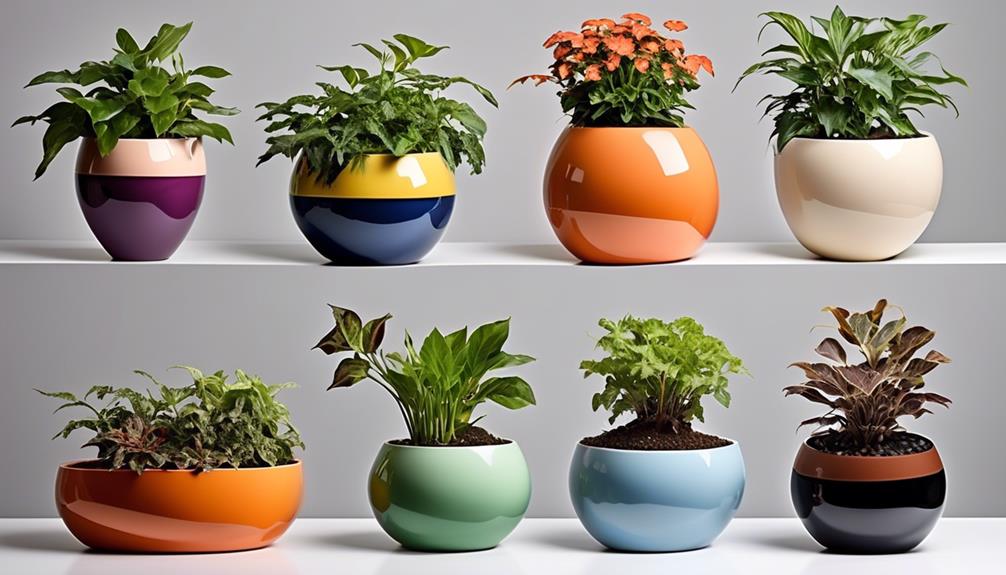
The growing fascination with gardening indoors is thoroughly noted. However, were you aware that the worldwide market for self-watering plant containers is expected to surpass $500 million by 2026?
With such a significant growth trajectory, it's clear that self-watering pots are becoming a staple in the gardening industry.
But what makes these pots so popular, and how can wholesale buyers take advantage of this trend?
Let's explore the benefits, practicality, and potential profitability of incorporating wholesale self-watering pots into your inventory.
Key Takeaways
- Wholesale self-watering pots provide consistent and efficient water delivery to plant roots.
- They help prevent overwatering or underwatering, creating an ideal environment for root development.
- Wholesale self-watering pots reduce watering frequency and contribute to water conservation.
- These pots operate on the principle of capillary action, maintaining soil moisture and minimizing water loss.
Benefits of Self-Watering Pots
Self-watering pots provide a consistent and efficient method for delivering water to plant roots, ensuring optimal hydration levels and promoting healthy growth. The watering efficiency of these pots is due to their unique design, which includes a water reservoir at the bottom. This reservoir allows the plant to draw up water as needed, preventing overwatering or underwatering, both of which can be detrimental to plant health. By maintaining consistent moisture levels in the soil, self-watering pots create an ideal environment for root development and overall plant vitality.
In addition to watering efficiency, self-watering pots offer the convenience of reduced watering frequency. The reservoirs can hold a significant amount of water, extending the time between refills. This not only saves time and effort for the gardener but also contributes to water conservation by minimizing runoff and evaporation. The combination of convenience and water conservation makes self-watering pots an attractive option for individuals seeking an efficient and sustainable approach to plant care.
How Self-Watering Pots Work
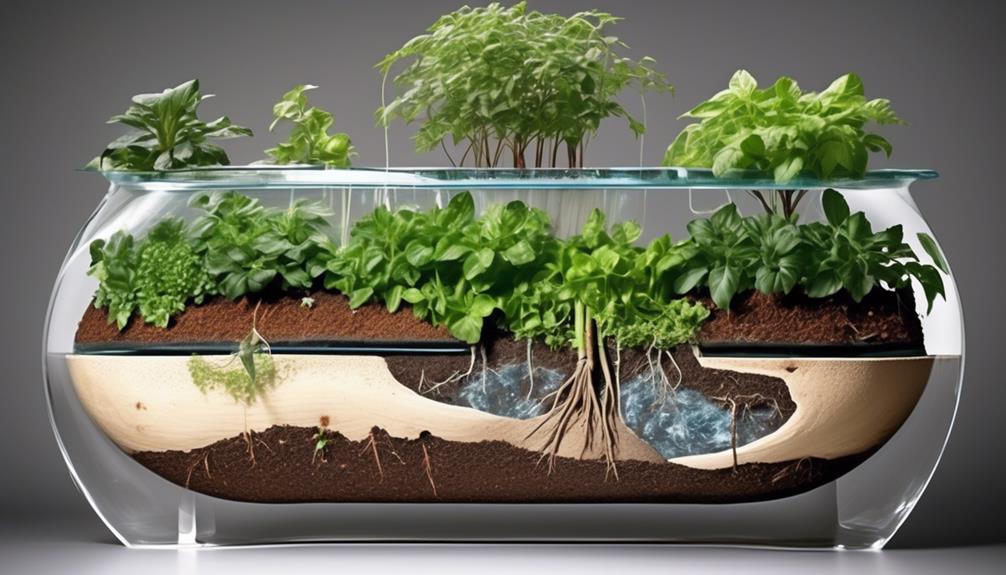
How do the water reservoirs in self-watering pots maintain consistent moisture levels in the soil? The watering mechanism in self-watering pots operates on the principle of capillary action. The pot is designed with a water reservoir at the bottom, separated from the soil by a wicking mechanism, such as a fabric wick or a soil column.
When the soil becomes dry, it creates a moisture gradient that draws water up from the reservoir through the wick and into the soil. This process continues until the soil reaches an optimal moisture level, at which point the capillary action ceases.
As the soil dries out again, the capillary action is reinitiated, ensuring that the soil moisture is maintained within the desired range.
The design of self-watering pots effectively prevents overwatering by allowing the plant to draw up only the amount of water it needs, while also minimizing water loss through evaporation. This mechanism provides a consistent and efficient way to keep the soil moisture at an ideal level for plant growth.
Choosing the Right Size
When selecting the right size self-watering pot, it's crucial to consider the specific type of plant being potted. Different plant species have varying root systems and water requirements, which directly influence the necessary pot size.
Additionally, the water reservoir capacity of the pot should align with the plant's water needs to ensure optimal hydration.
Lastly, the chosen pot size should also accommodate the available space and complement the overall aesthetics of the environment.
Size for Plant Type
Choosing the appropriate size of self-watering pot for your plant type is crucial for ensuring optimal growth and health of your plants. Plant compatibility and size considerations are essential factors to consider when selecting the right pot size.
For smaller plants with shallow root systems, such as herbs or small succulents, a pot with a diameter of 6-8 inches is suitable.
Medium-sized plants like peace lilies or spider plants thrive in pots with a diameter of 8-10 inches.
Larger plants, such as ficus or snake plants, require pots with a diameter of 12 inches or more to accommodate their extensive root systems and provide stability.
It's important to match the pot size to the specific needs of the plant to promote healthy growth and prevent issues such as root binding.
Water Reservoir Capacity
We can determine the appropriate water reservoir capacity for a self-watering pot by considering the plant's water needs and the pot's ability to maintain optimal moisture levels. Watering frequency and plant hydration levels are crucial factors in this determination.
The water reservoir capacity should align with the specific watering needs of the plant. For example, plants that require frequent watering will benefit from a larger water reservoir capacity to ensure consistent moisture levels. Conversely, plants that require less frequent watering may thrive with a smaller water reservoir capacity.
Additionally, the size of the plant and its root system should also be taken into account when selecting the water reservoir capacity.
Space and Aesthetics
Considering the plant's water needs and the pot's ability to maintain optimal moisture levels, a crucial aspect in selecting the right size for a self-watering pot pertains to accommodating the space and aesthetic requirements.
When it comes to space-saving, self-watering pots offer a practical solution for indoor and outdoor environments with limited space. The size of the pot should be chosen based on the available space and the specific plant's requirements, ensuring that it fits seamlessly into the designated area.
Additionally, stylish designs play a significant role in the overall aesthetic appeal of the space. Self-watering pots come in a variety of stylish designs, including sleek and modern options, as well as more traditional and decorative choices. These designs allow for the integration of self-watering pots into various design schemes, enhancing the overall aesthetic of the space while providing efficient water management.
Best Plants for Self-Watering Pots
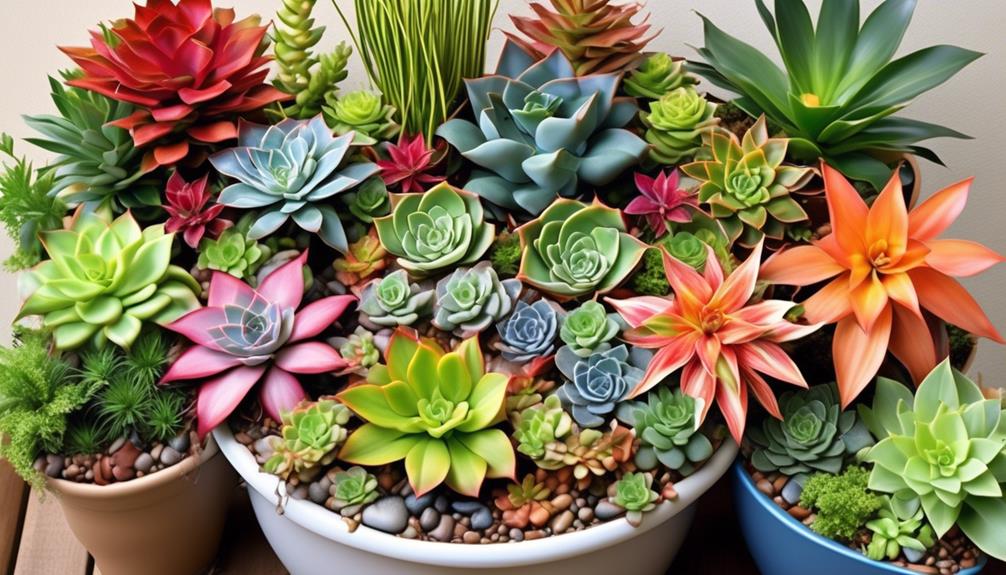
When selecting plants for self-watering pots, it's essential to consider their water requirements, growth habits, and adaptability to container gardening.
Ideal placement for plants in self-watering pots includes those that prefer consistent moisture levels, such as ferns, peace lilies, and certain species of palms. These plants thrive in environments where the soil remains consistently moist but not waterlogged, making them well-suited for self-watering pots.
Proper drainage is crucial for the health of plants in self-watering pots, as excess water can lead to root rot and other issues. Therefore, plants that are suited for self-watering pots should be able to tolerate damp soil without becoming waterlogged.
Additionally, plants with compact root systems, such as African violets and spider plants, are well-suited for self-watering pots due to their adaptability to limited space.
Considering these factors when selecting plants for self-watering pots will contribute to the successful and thriving growth of greenery in these containers.
Maintenance and Cleaning Tips
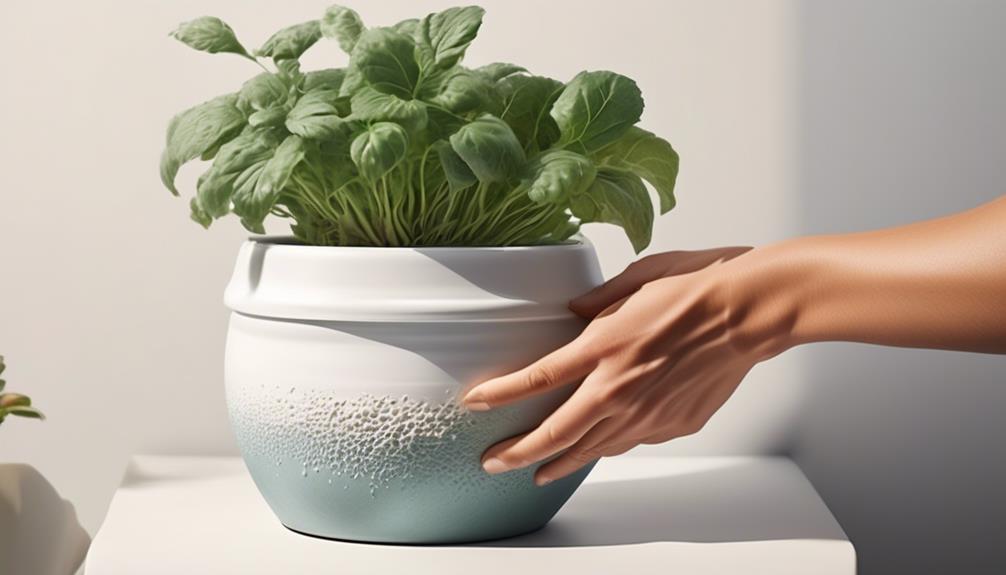
To maintain and clean self-watering pots, it is crucial to ensure proper drainage to prevent waterlogged soil and potential root rot, which can be detrimental to the health of the plants. Regular maintenance and cleaning are essential for the longevity and health of both the plants and the pots. Here are some effective cleaning techniques and longevity benefits to keep your self-watering pots in optimal condition:
| Cleaning Techniques | Frequency | Benefits |
|---|---|---|
| Remove mineral deposits | Every 2-3 months | Prevents clogging of watering system and ensures proper water flow |
| Scrub with mild soap | Every 6 months | Eliminates algae and mold buildup, maintains aesthetic appeal |
| Rinse and air dry | Every 1-2 weeks | Prevents bacterial growth and maintains soil moisture balance |
Implementing these cleaning techniques at the recommended frequencies will enhance the longevity of your self-watering pots, promoting healthy plant growth and reducing the risk of disease. Regular maintenance and cleaning not only benefit the plants but also contribute to the overall aesthetic and functionality of the pots.
Indoor Vs. Outdoor Use
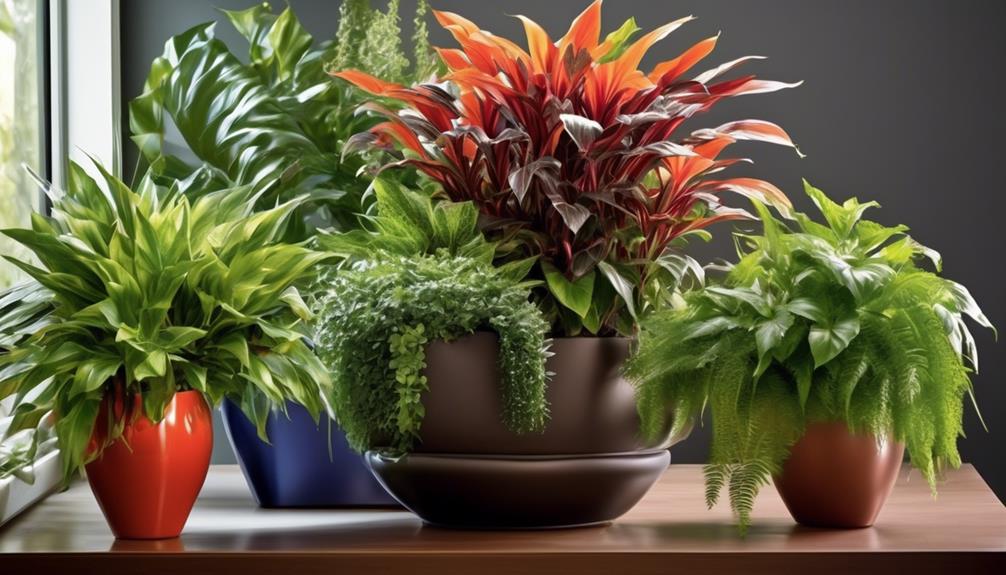
When deciding whether to use self-watering pots indoors or outdoors, it's important to consider the specific environmental factors and plant care requirements for each setting. For indoor plants, self-watering pots offer several advantages, including precise moisture control, reduced watering frequency, and protection against overwatering. However, outdoor gardening presents unique challenges that must be taken into account when using self-watering pots.
- Sunlight Exposure: Outdoor plants may receive more intense sunlight, which can increase evaporation and water consumption. Self-watering pots with larger reservoirs and UV-resistant materials are better suited for outdoor use to prevent water loss and maintain consistent moisture levels.
- Temperature Variations: Outdoor temperatures fluctuate more than indoor environments, affecting water absorption and plant hydration. Insulated self-watering pots with thermal properties can help regulate soil temperature and minimize water evaporation, ensuring optimal growing conditions for outdoor plants.
- Weather Resistance: Outdoor gardening exposes self-watering pots to harsh weather elements such as rain, wind, and frost. Durable, weatherproof materials and a sturdy construction are essential for withstanding outdoor conditions, protecting the pots from damage and maintaining their functionality over time.
Selecting the appropriate self-watering pots for indoor plants and outdoor gardening requires careful consideration of these factors to support healthy plant growth and minimize maintenance efforts.
Wholesale Buying Guide
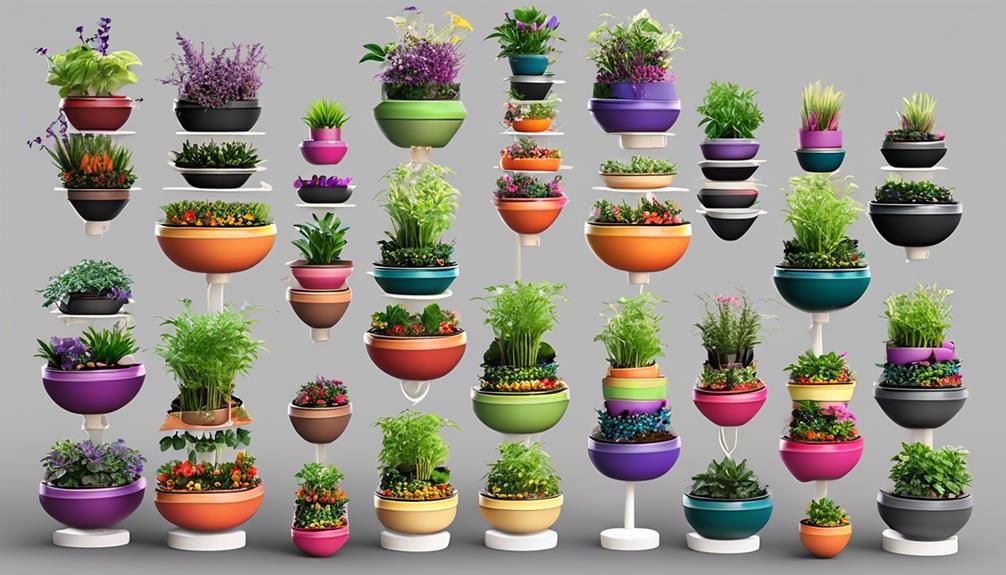
Considering the factors that affect indoor and outdoor plant care, our wholesale buying guide for self-watering pots emphasizes the importance of selecting durable, weather-resistant materials to ensure optimal functionality and longevity in various environmental conditions. When making wholesale purchasing decisions, it's essential to conduct thorough wholesale market research to identify reliable wholesale suppliers offering competitive wholesale pricing. Establishing a distributor network can also aid in managing bulk orders and streamlining wholesale inventory management.
| Factors to Consider | Description |
|---|---|
| Material | Choose high-quality, weather-resistant materials like UV-stabilized polypropylene for durability. |
| Size | Offer a variety of sizes to accommodate different plant types and potting needs. |
| Design | Opt for sleek, modern designs with a self-watering system for efficient water distribution. |
Popular Self-Watering Pot Designs
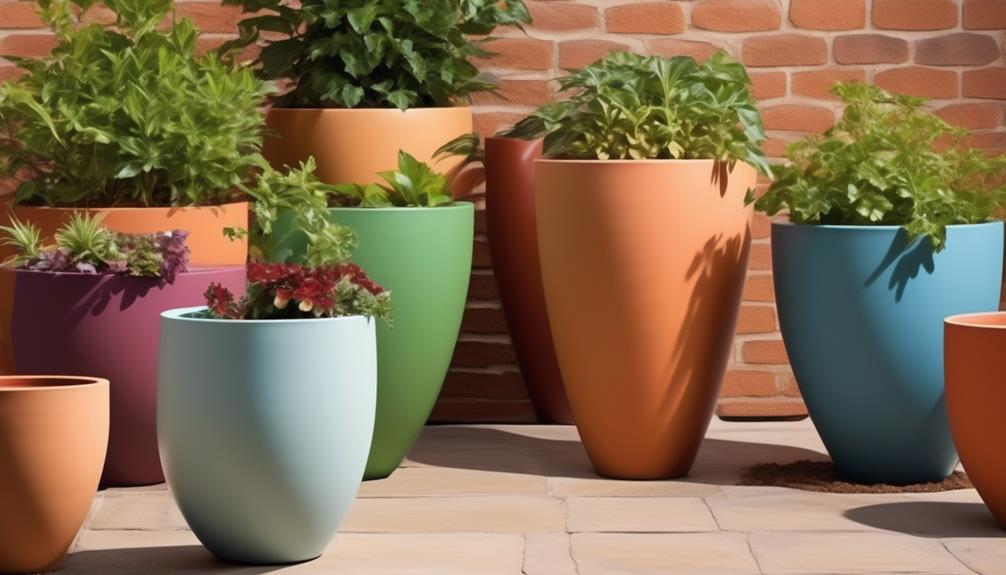
Exploring the market demand for self-watering pots has revealed a trend towards innovative designs that prioritize efficient water distribution and aesthetic appeal. Modern designs are integrating sustainability features to meet the evolving needs of consumers.
Some popular self-watering pot designs include:
- Modular Stacking Systems: These designs feature interconnected pots that allow for vertical stacking, maximizing space utilization. The modular system also provides efficient water distribution throughout the entire stack, ensuring each plant receives adequate moisture.
- Incorporated Water Reservoirs: Many modern self-watering pots are equipped with built-in water reservoirs, which allow for the storage of excess water. These reservoirs not only ensure a steady supply of water to the plants but also reduce water wastage by preventing runoff.
- Aesthetic Integration of Watering Mechanisms: Manufacturers are increasingly incorporating watering mechanisms into the overall aesthetic of the pot, seamlessly blending functionality with visual appeal. This integration enhances the overall design while maintaining the pot's sustainability features.
These modern designs with sustainability features are revolutionizing the self-watering pot market, catering to the needs of environmentally conscious consumers and offering efficient and visually appealing options for indoor and outdoor plant cultivation.
Maximizing Plant Health
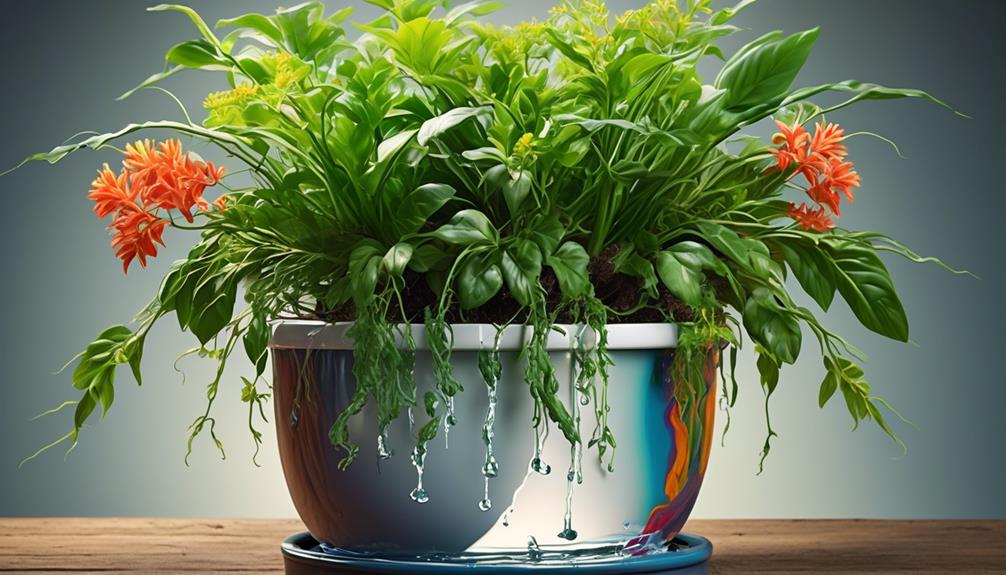
To ensure optimal plant health in self-watering pots, it is crucial to establish a balanced moisture level that meets the specific needs of the plant species being cultivated. Maximizing growth and promoting plant health requires a precise watering schedule tailored to the unique requirements of each plant. We must carefully consider factors such as the plant's water intake, soil composition, and environmental conditions when determining the watering frequency and volume. Below is a table outlining general guidelines for establishing an effective watering schedule based on common plant types:
| Plant Type | Watering Frequency | Watering Volume |
|---|---|---|
| Succulents | 2-3 weeks | Low |
| Herbs | 1-2 weeks | Moderate |
| Leafy Greens | 1 week | High |
Frequently Asked Questions
Are There Any Specific Plants That Should Not Be Grown in Self-Watering Pots?
We should consider the specific plants that are best suited for self-watering pots.
Some plants, such as succulents and cacti, may not thrive in self-watering pots due to their low water requirements.
Additionally, plants that prefer well-drained soil may face potential drawbacks as self-watering pots retain moisture.
It's important to carefully select plants that can adapt to the consistent moisture levels provided by self-watering pots for optimal growth.
How Often Should the Water Reservoir in Self-Watering Pots Be Refilled?
How often we need to refill the water reservoir in self-watering pots depends on various factors like the plant's water needs, environmental conditions, and the pot's size.
For most plants, checking the reservoir every 1-2 weeks is a good starting point. Factors like overwatering risks, soil moisture, and the type of plant will determine the exact frequency.
Certain plants with higher water needs may require more frequent refilling.
Can Self-Watering Pots Be Used in Conjunction With Traditional Watering Methods?
Yes, self-watering pots can be used in conjunction with traditional watering methods. The benefits include consistent moisture levels, reduced watering frequency, and improved plant health.
However, drawbacks may include the need for regular maintenance and monitoring of water levels. While effective, it's important to ensure proper maintenance to avoid issues such as water stagnation.
Are There Any Special Considerations for Using Self-Watering Pots in Extreme Weather Conditions?
When dealing with extreme temperatures, special considerations for using self-watering pots are essential.
The pot material and insulation play critical roles in maintaining optimal conditions for plant growth.
Additionally, the drainage system and watering frequency must be adjusted to prevent waterlogging or dehydration.
It's like navigating a ship through turbulent waters; meticulous care is needed to ensure that the plants thrive despite the challenging conditions.
What Are the Typical Wholesale Pricing Options for Self-Watering Pots?
Typical wholesale pricing options for self-watering pots can vary depending on factors such as materials, size, and features. Wholesale suppliers offer competitive pricing to meet market demand and encourage product innovation.
The benefits of wholesale pricing include cost savings and bulk purchasing options. However, drawbacks may include minimum order quantities and shipping costs.
Understanding market demand and staying updated on product innovation can help in navigating wholesale pricing options for self-watering pots.
Are Wholesale Self Watering Pots Effective for Keeping Plants Hydrated?
Yes, wholesale self watering pots effectiveness for keeping plants hydrated cannot be denied. These pots offer a constant supply of moisture to the plants, keeping them hydrated for longer periods. The effectiveness of self watering pots makes them a popular choice for both indoor and outdoor gardening.
Conclusion
In conclusion, wholesale self-watering pots offer a convenient and efficient solution for maintaining healthy plants. With the right size and design, these pots can help maximize plant health by providing consistent moisture.
Just like a well-oiled machine, self-watering pots keep plants thriving with minimal effort. Whether for indoor or outdoor use, these pots are a game-changer for anyone looking to simplify their plant care routine.
Consider investing in wholesale self-watering pots to elevate your gardening experience.
-
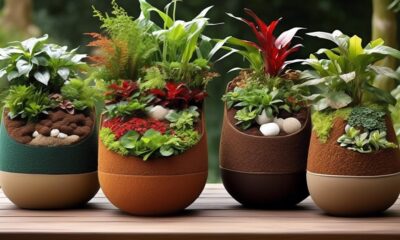
 Vetted5 days ago
Vetted5 days ago15 Best Wicking Materials for Self-Watering Planters, Tried and Tested
-
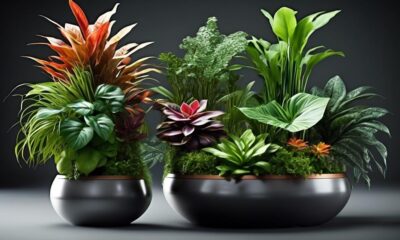
 Vetted3 weeks ago
Vetted3 weeks ago15 Best Self-Watering Pots to Keep Your Plants Thriving
-

 Vetted3 weeks ago
Vetted3 weeks ago15 Best Terrace Planters to Elevate Your Outdoor Space
-
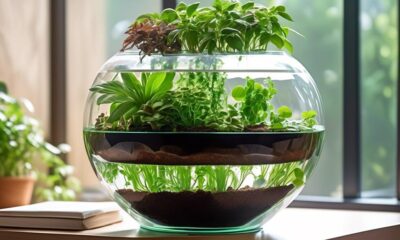
 Self Watering Plant Pots3 weeks ago
Self Watering Plant Pots3 weeks agoHow Do Self Watering Planter Pots Work
-
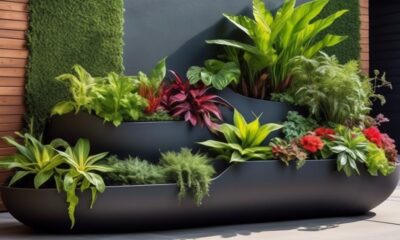
 Vetted3 weeks ago
Vetted3 weeks ago15 Best Wicking Planters to Keep Your Plants Thriving and Healthy
-
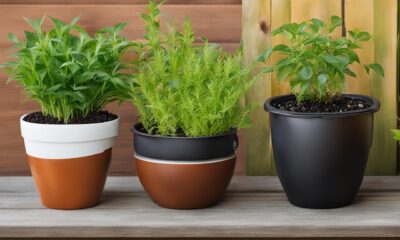
 Self Watering Plant Pots1 week ago
Self Watering Plant Pots1 week agoSelf Watering Outdoor Pots: Do They Work?
-

 Vetted3 weeks ago
Vetted3 weeks ago15 Best Waterwick Pots to Keep Your Plants Thriving and Healthy
-
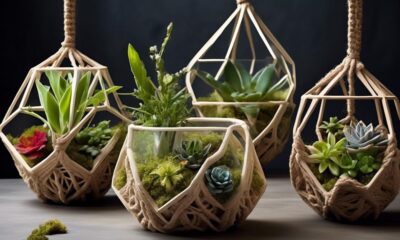
 Vetted3 weeks ago
Vetted3 weeks ago15 Unique and Wicked Planters to Elevate Your Indoor Garden
















